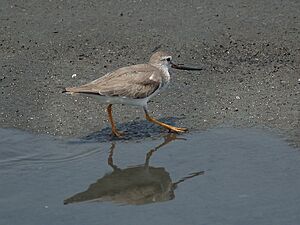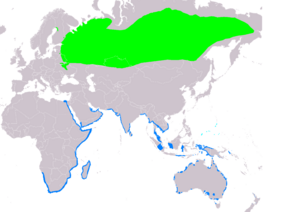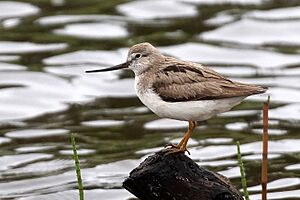Terek sandpiper facts for kids
Quick facts for kids Terek sandpiper |
|
|---|---|
 |
|
| Conservation status | |
| Scientific classification | |
| Genus: |
Xenus
|
| Species: |
cinereus
|
 |
|
| Range of X. cinereus (Compiled by: BirdLife International and Handbook of the Birds of the World (2019) 2019) Breeding Passage Non-breeding | |
| Synonyms | |
|
Tringa cinerea |
|
The Terek sandpiper (Xenus cinereus) is a small bird that loves to travel! It's a type of wader, which means it's a bird that often walks in shallow water or mud. This bird is the only one in its special group, called a genus, named Xenus.
It gets its name from the Terek River. This river flows into the western part of the Caspian Sea. People first saw this unique bird around that area.
Contents
Discovering the Terek Sandpiper
The Terek sandpiper was first officially described in 1775. A German scientist named Johann Anton Güldenstädt gave it the scientific name Scolopax cinerea. He saw pairs of these birds raising their young near where the Terek River meets the Caspian Sea.
Today, this bird is the only species in the group Xenus. Another German scientist, Johann Jakob Kaup, created this group in 1829. The name Xenus comes from an old Greek word meaning "stranger." The second part of its name, cinereus, is Latin for "ash-grey." This describes the bird's color.
Family Tree of the Terek Sandpiper
The Terek sandpiper belongs to a larger bird family called Scolopacidae. This family includes many shorebirds. Scientists believe the Terek sandpiper is related to birds like shanks and tattlers. It's not as closely related to the calidrid sandpipers.
Scientists think the Terek sandpiper's ancestors separated from their relatives a very long time ago. This was about 23 to 22 million years ago! This happened around the time a large ancient sea, called the Turgai Sea, started to dry up in Eurasia.
What Does the Terek Sandpiper Look Like?
The Terek sandpiper is a bit bigger than a common sandpiper. It is about 22 to 25 centimeters (8.7 to 9.8 inches) long. Its most special feature is its long, upward-curved beak. It looks a bit like an avocet's beak, but not quite as curved.
This bird has a grey back, face, and chest. Its belly is whitish. It also has yellow feet. The bottom part of its beak is yellowish, and the rest is black. Sometimes, you can see a white stripe above its eye.
The Terek Sandpiper's Call
When the Terek sandpiper calls, it makes a high whistling sound.
Where Do Terek Sandpipers Live and Travel?
These birds build their nests near water in the northern forests, called the taiga. They live from Finland all the way across northern Siberia to the Kolyma River. When winter comes, they fly south to warmer places. They travel to tropical coasts in East Africa, South Asia, and Australia. They usually like muddy areas.
Sometimes, a few Terek sandpipers fly off their usual path. They are rarely seen in Western Europe. They are sometimes spotted in the Marianas islands during their migration. A few birds also fly to Alaska and the Aleutian Islands almost every year. Very rarely, some even fly as far south as Argentina!
Genetic Diversity and Behavior
Scientists have found that Terek sandpipers across their range are quite similar genetically. This means they are closely related. However, the group living near the Dnieper River in Eastern Europe is a bit different.
The Terek sandpiper has a very active way of finding food. It chases insects and other small moving creatures. Sometimes, after catching something, it runs to the water's edge to wash its meal.
Reproduction and Nesting
Terek sandpipers lay three or four eggs. They make a simple nest on the ground, lining it with soft materials.
These birds often hang out with other shorebirds. They like to be with ruddy turnstones and small plovers. One Terek sandpiper seen in Brazil even paired up with a spotted sandpiper!
Conservation Status
The Terek sandpiper is part of an important agreement called the Agreement on the Conservation of African-Eurasian Migratory Waterbirds (AEWA). This agreement helps protect birds that migrate across Africa and Eurasia.
The Terek sandpiper is quite common and widespread. Because of this, the IUCN (International Union for Conservation of Nature) does not consider it a threatened species. This is good news for the Terek sandpiper!
Gallery
-
Terek sandpiper Xenus cinereus, little stint Calidris minuta and marsh sandpiper Tringa stagnatilis in Krishna Wildlife Sanctuary, Andhra Pradesh, India.
-
Eating a ragworm in Shōnai River, Japan.









